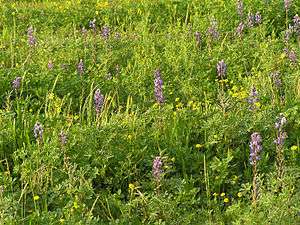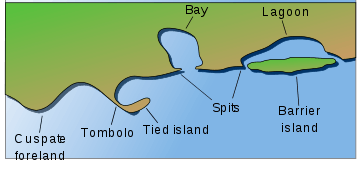Ballona Wetlands


The Ballona Wetlands are located in Southern California, United States south of Marina del Rey and east of Playa del Rey. The wetlands once included the areas now taken up by Marina del Rey, Venice, and Playa Vista, extending north to about present-day Washington Blvd. in Venice.[1]
It is one of the last significant wetlands areas in the Los Angeles basin, and is named for Port Ballona and Ballona Creek which now runs through the area as a flood control channel. In the 1930s the Ballona Creek corridor was channelized in concrete,[2] thus greatly reducing the inflow of salt water to the marsh, and eliminating spring floods, which brought freshwater to the wetlands. Among the many groups dedicated to protecting the wetlands are the Friends of Ballona Wetlands, the Ballona Wetlands Land Trust, Grassroots Coalition, Ballona Ecosystem Education Project, and the Sierra Club Airport Marina Group.
History
Tongva Native Americans
Mexican ranchos and early American era
Water control
The Ballona Creek Flood control channel, and the construction of Marina del Rey in the late 1950s, reduced the 2,100-acre (8.5 km2) estuary to some 700 acres (2.8 km2). Additional open space east of the wetlands was converted to agricultural uses by the early 20th century, with cultivation continuing into the 1990s, when these became some of the last farm fields in the Los Angeles Basin. In the 1940s, much of these farm fields became the private Hughes Airport. In first decade of the 21st century that land was developed as Playa Vista, a planned mixed-use community east of Lincoln Boulevard.
Land owners and issues
The State of California owns and the California Department of Fish and Wildlife (CDFW) manages the wetlands. Approximately 577 acres (2.34 km2), are bisected generally east-west by the Ballona Creek channel, from Playa Del Rey to Culver City, and bordered by the 90 Marina freeway to the east. 83 acres (340,000 m2) of Estuarine wetland were included in the state acquisition, previously privately owned by Howard Hughes, his corporate heirs and the subsequent developers of Playa Vista.
These estuarine wetlands, and the remaining open space, have been the subject of a battle between developers and environmentalists that has been ongoing for decades. Numerous environmental lawsuits and the acquisition of a part of the Wetlands by the State of California has helped to protect a portion of this area, including nearly all the open space west of Lincoln Blvd. (including all of the remaining tidal wetlands).[3] In 2002, remains of California Native American Tongva villages, artifacts, and buried ancestors were found during excavation on the Playa Vista site.
The Ballona Wetlands Restoration Project
On January 28, 2013, the Annenberg Foundation signed a Memorandum of Understanding with the California Department of Fish and Wildlife and several other state agencies to explore the possibility of creating an interpretive center and related public access amenities for the Ballona Wetlands Ecological Reserve (BWER).[4] The Annenberg Foundation suspended its controversial plan to build a $50-million visitors center in the Ballona Wetlands Ecological Reserve in December 2014.[5]
On September 25, 2017, the California Department of Fish and Wildlife released, for public review and comment, its draft Environmental Impact Report detailing three restoration alternatives.
Natural history
Flora - plants
The Ballona Wetlands, is a habitat of a marine estuary with its surrounding ecosystems. Historically the outlet-mouth of the Los Angeles River switched, between San Pedro Bay and the Ballona creek watercourse to Santa Monica Bay, several times a century. It last came through Ballona in the early 19th century. The alluvium it left makes up the soils below. Some unique plants here are: the Ballona wallflower, southern tarplant, Lewis' primrose, and lupines.[6]
Chaenactis glabriuscula var. orcuttiana — Orcutt's yellow pincushion, is a rare native plant limited to the coastal dunes of southern California. The Ballona Wetlands and Bell Avenue Sand Dune Park in Manhattan Beach, each had var. orcuttiana populations newly discovered in spring 2010.[7][8] The variety is listed by the California Native Plant Society as endemic to California coastal dunes ecosystems and significantly declining.[8]
Fauna
The estuary is home for such wildlife as: great blue heron and snowy egret rookeries, the California killifish, the California least tern, and the Belding's Savannah sparrow. The Ballona Wetlands and the adjacent city-owned lagoons are a stop along the migratory Pacific Flyway.
See also
References
- ↑ Former Ballona Wetlands Area Archived January 21, 2008, at the Wayback Machine.
- ↑ Ballona Creek Cement Channel Archived May 11, 2008, at the Wayback Machine.
- ↑ Ballona Wetland Restoration Project Description Archived June 20, 2007, at the Wayback Machine.
- ↑ Ballona Wetlands Restoration Project
- ↑ Groves, Martha (December 2, 2014) "Annenberg Foundation suspends plan for Ballona Wetlands visitors center" Los Angeles Times
- ↑ Masters, Nathan (February 29, 2012). "The Lost Wetlands of Los Angeles". KCET. Retrieved 3 March 2018.
- ↑ Sahagun, Louis (March 19, 2010) "Discovery of rare wildflower in Ballona Wetlands could halt recreation project." Los Angeles Times Retrieved 3 March 2018
- 1 2 Agostoni, Kristin (May 17, 2010). "Rare plant species discovered at Sand Dune Park". The Daily Breeze. Retrieved 3 March 2018.
Further reading
- "Ballona Historical Ecology". Center for Geographical Studies, Geographical Information Center (GIC) at California State University, Chico, San Francisco Estuary Institute, Southern California Coastal Water Research Project, University of Southern California, The Bay Foundation. Retrieved 3 March 2018.
External links
- Restoration Project Homepage
- Santa Monica Bay Restoration Foundation
- Friends of Ballona Wetlands
- Heal the Bay
- EPA Santa Monica Bay Watershed Profile
- Birds of Ballona
- Gallery of Bird photos at Ballona
- Video of The Ballona Wetlands
- Ballona Wetlands Land Trust
- Ballona Ecosystem Education Project, Since 1985
| Wikimedia Commons has media related to Ballona Wetlands. |
Coordinates: 33°57′37″N 118°26′54″W / 33.960295°N 118.448211°W



